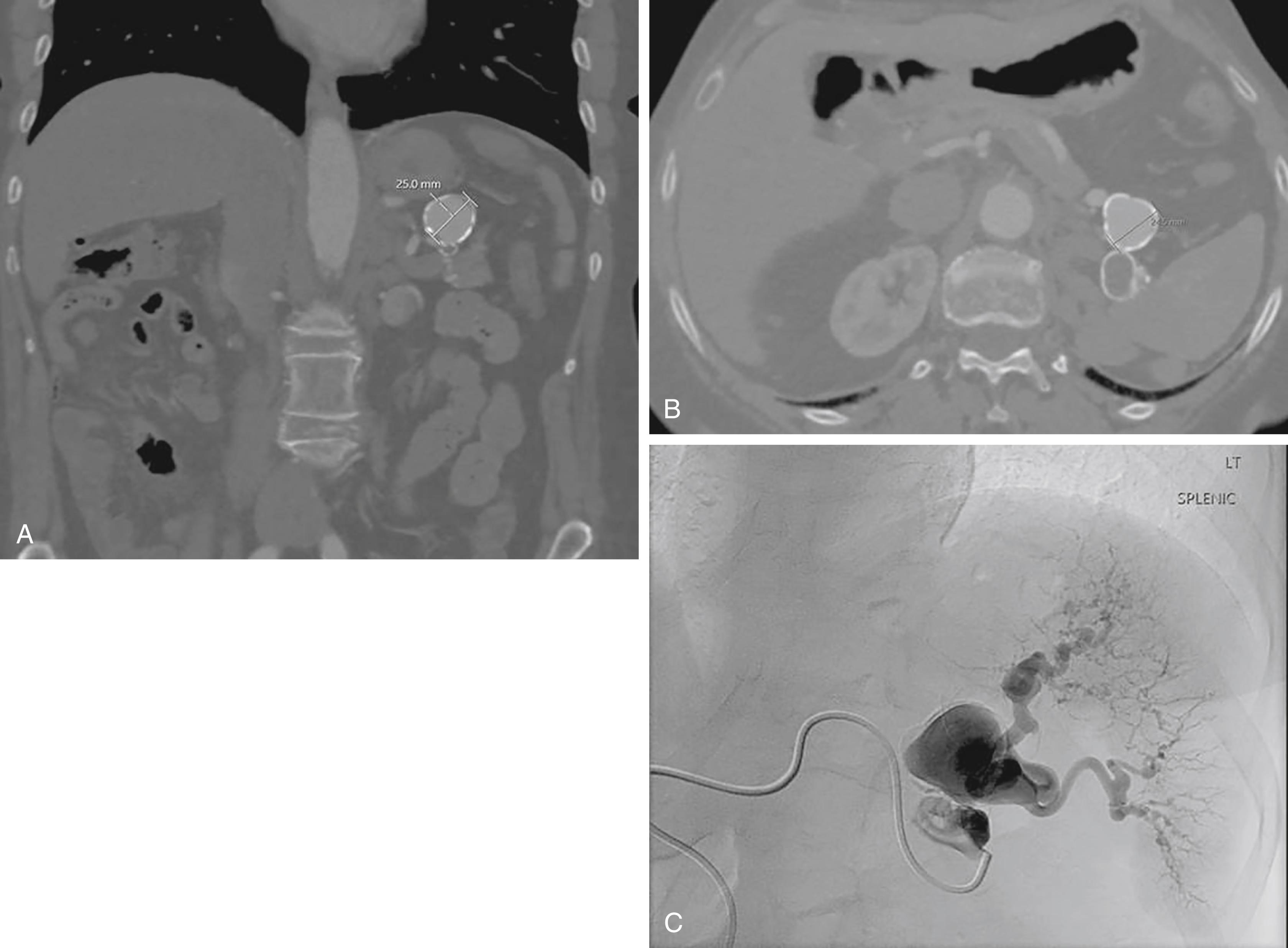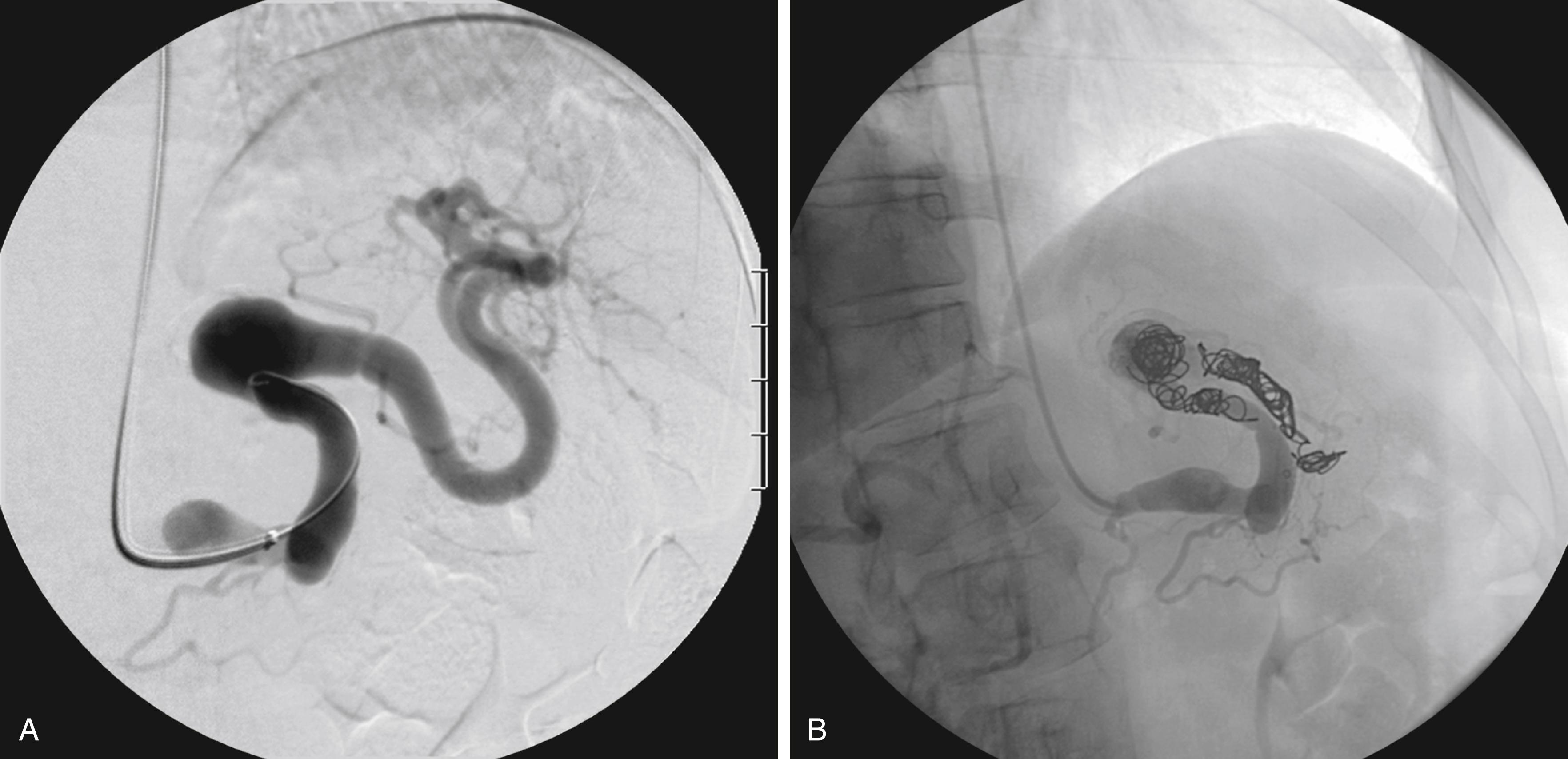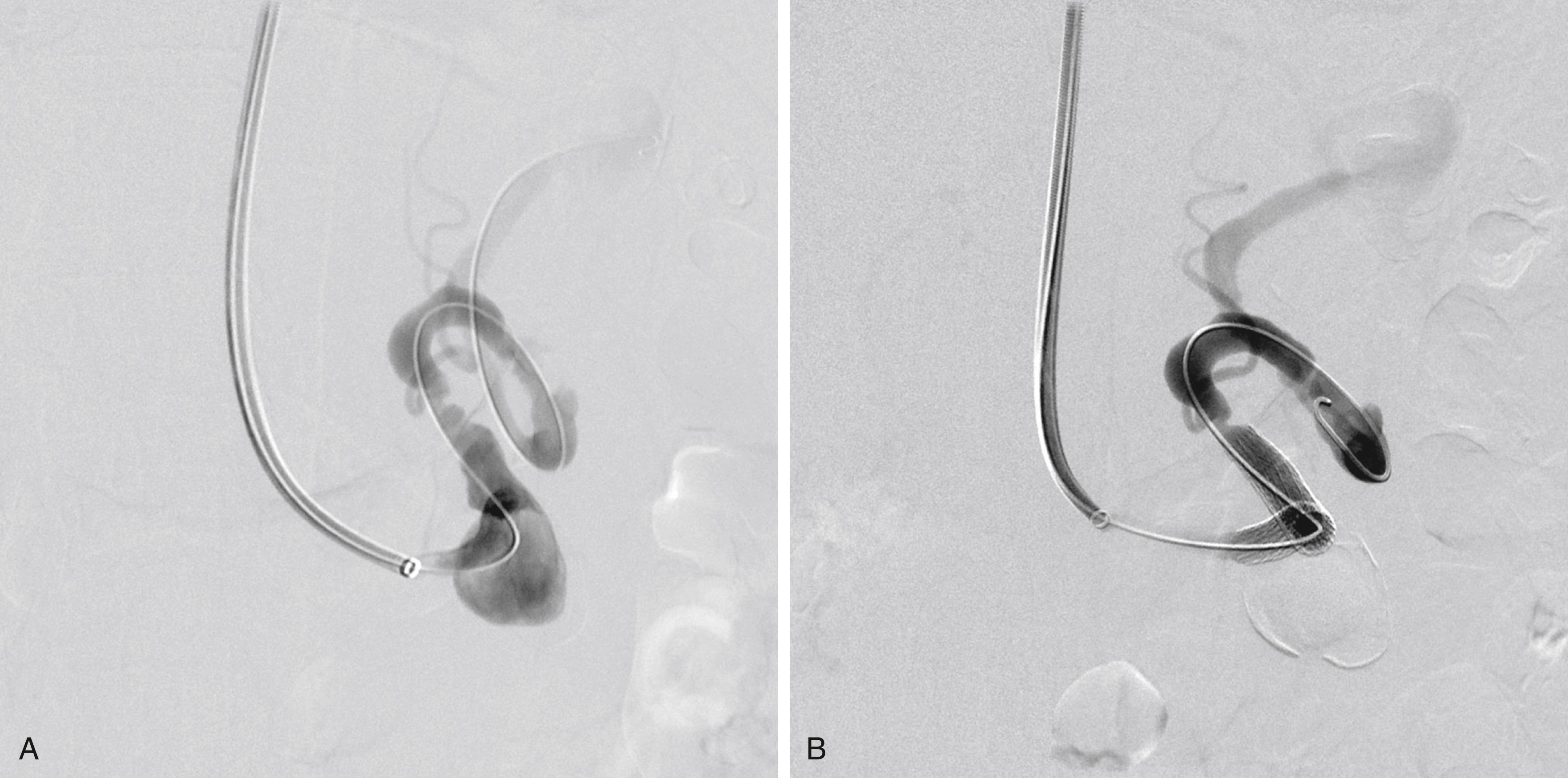Physical Address
304 North Cardinal St.
Dorchester Center, MA 02124
Even though visceral artery aneurysms represent a rare pathology, they have important significance because of their potentially lethal clinical course. These lesions were described more than 200 years ago, and initial case reports consisted mostly of emergent interventions for rupture. Diagnosis in these cases was often made postmortem. The first reported successful operative repair was performed by Kehr in 1903; it consisted of ligation of a proper hepatic artery aneurysm (HAA). This was followed many years later in 1951 by Paul, who described ligation and revascularization of a traumatic HAA, and in 1953 by DeBakey and Cooley, who described their repair of a mycotic superior mesenteric artery (SMA) aneurysm. Since that time, evidence has been steadily accumulating in the vascular literature, and the natural history of these aneurysms is becoming better understood. Additionally, the advent of modern technologic advances – including improved imaging modalities along with complex endovascular techniques – has revolutionized the management of these often lethal entities. This chapter reviews the previous experience as documented in the literature and highlights the management guidelines for the various types of visceral artery aneurysms.
Traditionally an aneurysm is defined as a dilation or enlargement of an artery more than 1.5 to 2 times its normal diameter. Visceral (or splanchnic) artery aneurysms include those affecting the celiac artery, SMA, inferior mesenteric artery (IMA), and their branches. Aortic and renal artery aneurysms are excluded in this categorization despite the fact that they encompass approximately 95% of all intraabdominal aneurysms. Nearly one-third of patients with a visceral artery aneurysm will have an associated aortic, renal, iliac, lower extremity, or cerebral artery aneurysm, signifying the importance of screening these individuals. The overall incidence in the adult population is estimated to range from 0.1% to 2%, which, based on autopsy review, increases to 10% in the elder population. Splenic artery aneurysms (SAAs) encompass the majority (60%); followed by HAAs, 20%; superior mesenteric artery aneurysms (SMAAs), 6%; celiac artery aneurysms (CAAs), 4%; gastric artery aneurysms (GAAs), 4%; jejunal, ileal, and colic artery aneurysms (4%); pancreaticoduodenal artery aneurysms (PDAAs), 2%; gastroduodenal artery aneurysms (GDAAs), 1.5%; and inferior mesenteric artery aneurysms (IMAAs), less than 1%.
Causes of true visceral aneurysm formation include atherosclerosis, medial degeneration, collagen vascular diseases, and fibromuscular dysplasia. Other factors – such as multiparity, portal hypertension, and posttransplant status – have been implicated in true SAA formation, and celiac artery occlusive disease has been implicated in true GDAA and PDAA formation. Visceral pseudoaneurysms result from infectious or inflammatory conditions, vasculitis, surgery/iatrogenic intervention, and trauma. , , Furthermore, evidence suggests that pseudoaneurysms display relatively rapid growth soon after the initial insult, such that treatment strategies should focus on early intervention regardless of size. However, aneurysmal morphology can impact treatment options and the application of endovascular therapies.
Rare medical conditions such as von Recklinghausen disease, Ehlers–Danlos syndrome, periarteritis nodosa, and Behçet disease have been implicated in the development of visceral aneurysms. Reported case series have demonstrated the association of multiple visceral aneurysms with systemic arteritis, endocarditis with septic emboli, connective tissue disorders, and even excessive use of acetaminophen.
Advances in endovascular therapies have caused a paradigm shift in the management of visceral artery aneurysms. These aneurysms can be managed by a variety of methods including open surgery, laparoscopic surgery, endovascular techniques, or any combination of these modalities. A prior review including 27 published case series of visceral artery aneurysms concluded that there is no consensus dictating indications for treatment or specific treatment options. Expert opinion indicates that this is guided by patient and aneurysmal characteristics. Patient age, gender, and comorbidities in conjunction with aneurysmal size, anatomic location, and collateral circulation should dictate optimal management strategies.
The elective treatment of visceral artery aneurysms allows for complete evaluation and imaging with ultrasound, CT, MRI, or a combination of these. Diagnostic angiography is usually combined with percutaneous intervention. A thorough evaluation of the patient should address any history of trauma, pancreatitis, or any other infectious/inflammatory process to ascertain etiology and risk of rupture. Past surgical intervention or hepatobiliary instrumentation, current pregnancy status, history of pregnancies, and risk factors associated with atherosclerosis are also pertinent. Patients undergoing SAA embolization or ligation may be at risk for splenic loss and should receive pneumococcal, meningococcal, and Haemophilus influenzae type b vaccinations. A recent literature review noted the benefits of endovascular treatment options in the elective setting, particularly in poor surgical candidates and patients with a hostile abdomen.
Ruptured visceral artery aneurysms represent a true surgical emergency, and patients should be expeditiously transferred to the operating room for exploratory laparotomy in the setting of hemodynamic collapse. Often, the preoperative diagnosis is ruptured abdominal aortic aneurysm and exploration leads to the actual ruptured artery. Ligation of the visceral aneurysm can be performed with or without vascular reconstruction. Patients presenting with ruptured SAAs are most often treated with concomitant splenectomy. Given the extensive collateralization of the viscera, vascular reconstruction is rarely needed in the emergent treatment of proximal HAAs, PDAs, and GAAs. , When mesenteric arterial aneurysms are ligated, small bowel affected by ischemia may require resection. Arterial reconstruction may be necessary for ruptured SMAAs and CAAs. Endovascular management of ruptured visceral artery aneurysms has been reported as a feasible option but should be used selectively. ,
Most large case series involving the management of visceral artery aneurysms have included an observational cohort, with encouraging results. , , , , The majority of observational cases involve the splenic artery. Recently released guidelines state that SAAs less than 3 cm in size that are asymptomatic and show little to no growth can be safely observed and monitored with serial imaging. Women who are either pregnant or of childbearing age should have any SAA treated regardless of size. There is no firm evidence to show that aneurysmal calcification protects against growth or rupture, but calcified SAAs ( Fig. 87.1 ) may be associated with smaller size at initial diagnosis. Most series advocate for all pseudoaneurysms to be treated irrespective of size or location owing to their rapid growth rate and propensity to rupture. , There is also evidence to support intervention in all SMAAs, GDAAs, and PDAAs because of their high rupture rate and the associated mortality. ,

Treatment of visceral artery aneurysms with open surgery has been established as a safe and durable standard. Expeditious ligation of both the proximal and distal branches is generally performed without reconstruction in the case of frank rupture and hemodynamic collapse and during elective cases if adequate collateralization to end organs is present. The spleen has a rich blood supply from the short gastric arteries and pancreaticoduodenal arcade, which usually allow the splenic artery to be sacrificed without major consequence. The celiac axis and common hepatic artery can also be ligated if there is sufficient collateralization from the gastroduodenal and pancreaticoduodenal arteries and the portal vein is patent. Vein grafts should be used preferentially in cases of suspected infection or bowel ischemia. Arterial ligation is the procedure of choice in the setting of free rupture.
The immediate benefits associated with endovascular intervention include a shorter hospital stay, the use of local/conscious sedation, lower cost, and faster recovery. Patients with comorbidities prohibitive to open surgical management, including intraabdominal malignancy and previous surgery, can also benefit from minimally invasive techniques. Drawbacks to endovascular repair include the risk of access-related injury, contrast toxicity, end-organ embolization, a relatively higher rate of failure compared with open surgery, and the need for prolonged postembolization imaging surveillance. Treatment by means of endovascular intervention can be achieved through several different modalities often in combination, including deployment of coils and glue, injection of particles or Gelfoam, placement of covered stents or flow-diverting stents (FDSs), and injection of thrombin or ethyl alcohol. , , , , Results of the endovascular treatment of 48 consecutive patients (60% men, mean age 58) with 20 visceral artery aneurysms and 28 visceral artery pseudoaneurysms have been reported. The endovascular treatment of visceral artery aneurysms was technically successful in 98% of 48 these procedures, comprising 20 splenic arteries, 12 hepatic arteries, 1 SMA, 3 celiac axis arteries, 2 pancreaticoduodenal arteries, 2 left gastric arteries, 7 gastroduodenal arteries, and 1 middle colic artery. Coil embolization was used for aneurysm exclusion in 96% of the cases, and N -butyl-2-cyanoacrylate (glue) was used selectively in 19%. The 30-day mortality was 8.3%, with all perioperative deaths occurring in patients who required urgent or emergent intervention in the setting of hemodynamic instability. Complete exclusion of flow within the aneurysmal sac occurred in the 97% interventions with follow-up imaging, with postembolization syndrome (PES) developing in three patients (6%) after splenic artery embolization. Another report detailed the endovascular treatment results of 185 visceral artery aneurysms encountered over 10 years in three distinct geographies. Thirty-four percent of the aneurysms were located in the splenic artery, followed by 30% in the hepatic artery. Initial intervention was successful 98% of the time. Coiling was used alone in 75% of the cases and in combination with at least one other technique in 11% of cases. Thirty-day aneurysm-related mortality was low at 3.4%, and all involved death due to bleeding.
Ablation of visceral artery aneurysms through endovascular intervention can be accomplished with nitinol coils, cyanoacrylate glue, thrombin, and even ethyl alcohol. A unique characteristic of cyanoacrylate glue is that the rate of glue polymerization can be altered for precision targeting using ethiodized oil dilution in different ratios. A 3-Fr microcatheter is useful for intervention in the distal aspect of an arterial aneurysm before selective embolization material is deployed. Both true aneurysms and pseudoaneurysms of the visceral circulation can be managed with embolization. Endovascular exclusion to both inflow and outflow can be achieved by placement of coils first distally, in the sac, and then proximally to the sac ( Fig. 87.2 ). For aneurysms supplied by terminal branches, the sac can be directly injected or coiled.

In selected cases, a covered self-expanding stent may be placed to maintain flow within a vessel ( Fig. 87.3 ). This technique is often limited by relatively large, rigid delivery devices that are not ideal for navigating secondary and tertiary visceral branches. Covered stents also risk occluding flow into side branches of the target vessel.

Follow-up imaging is not limited by artifact from radiopaque coils or glue, and this notable advantage of covered stent placement over embolization has allowed for accurate documentation and surveillance of aneurysm sac growth or shrinkage.
FDSs, sometimes referred to as multilayer stents, are specially designed to reduce flow velocity in the aneurysmal sac while promoting thrombosis in the sac and maintaining flow within the main artery and any branch vessels. The FDSs were originally developed for the endovascular treatment of intracranial aneurysms. By 2010, this technology had been used to treat over 2500 intracranial aneurysms. Initial case reports demonstrated success in multiple peripheral and visceral vascular vessels. A prospective, multicenter study of FDS use in 19 visceral artery aneurysms recently reported encouraging results of freedom from rupture, patency of the stents and vessel branches, aneurysmal thrombosis, sac shrinkage, and low morbidity and mortality. Widespread use of these modalities should be tempered, however, until more experience regarding efficacy becomes available.
SAAs have been established as the most common of the visceral artery aneurysms, accounting for nearly 60% of reported visceral aneurysms. Like any visceral artery aneurysm, their clinical significance is related to the potential for rupture. The most accurate calculated incidence in the general population is most often cited as 0.78%, which is based on a review of incidentally noted SAAs seen on nonselective angiography. One general autopsy study cited the overall incidence to be 0.01%, with incidence increasing to 10.4% in an elder population autopsy series. In contrast to other arterial aneurysms, SAAs disproportionately affect females at a ratio of 4:1 over males. , Although incidence increases markedly in the elder population, they occur at a younger age compared with other visceral aneurysms. ,
Most SAAs are close to 2 cm in diameter when initially noted. Reports of SAAs associated with symptoms and/or with rupture average closer to 3 cm at presentation. , , The majority of these aneurysms have saccular morphology and are located more commonly in the mid- or distal splenic artery and its bifurcations. , The rare phenomenon of a “giant” SAA greater than 10 cm in diameter has been encountered in the literature and seems to be found more often in men.
The underlying pathologic processes in the development of most SAAs are related to atherosclerosis, arterial fibrodysplasia, and arteritis. , Associated risk factors include female gender, multiparity, and portal hypertension. , Several reports have established an association between multiparity and SAA development, , but the precise interactions of hormonal influence, fibromuscular dysplasia, and wall stress are not yet fully understood. , Some series have noted that nearly 50% of females with more than six pregnancies had been diagnosed with an SAA. , Yet another noted that 80% of females with SAAs had averaged 4.5 pregnancies. Still, the utility of screening women for SAAs who are either pregnant or of childbearing age has been proven to be unwarranted in one study. The association between SAAs and portal hypertension has been documented, especially in patients undergoing orthotopic liver transplantation. Evaluations of patients with known portal hypertension or cirrhosis have shown a likely incidence of SAA incidence ranging from 10% to 20%, with one study reporting an incidence as high as 50%.
Notable etiologies of splenic artery pseudoaneurysm formation include blunt trauma, infection, and pancreatitis. Pseudoaneurysm formation associated with pancreatitis has been attributed to digestion of the splenic artery by pancreatic enzymes. Splenic artery pseudoaneurysm associated with chronic pancreatitis represents the leading cause of hemosuccus pancreaticus, a rare cause of upper chronic and intermittent gastrointestinal hemorrhage, usually due to the rupture of a visceral aneurysm into the main pancreatic duct.
Prior to the introduction of modern imaging techniques it was estimated that more than 10% of SAAs were ruptured at the time of diagnosis. , Most current case series report that SAAs are incidental findings noted on imaging performed for unrelated symptoms. In cases not associated with pregnancy, SAAs have a relatively low rupture rate of less than 2%. Most patients with otherwise asymptomatic SAAs will have benign physical examinations. Hemodynamic collapse secondary to rupture is most often accompanied by acute left-sided abdominal pain. The patient will typically present in extremis as a result of free intraperitoneal rupture and shock. On occasion the initial rupture may be contained in the lesser sac. This “double rupture” phenomenon, which occurs after initial tamponade of splenic artery hemorrhage into the lesser sac, can occur in up to 25% of ruptured SAA cases and can sometimes precede free rupture into the retroperitoneum by as long as 4 days. , Mortality reports associated with ruptured SAAs range from 10% to 25%. , ,
Pregnancy is a significant contributing risk factor and may be associated with as many as half of all ruptures. , Significant maternal and fetal mortality has been documented to be close to 75% for pregnant women and about 95% for the fetus. , Rupture occurs almost exclusively in the third trimester; there are only a handful of reports of rupture in the first trimester in the literature. Although the prevalence of SAAs in pregnancy is thought to be low, at only 0.1% in one series, their clinical importance is highlighted by the fact that over 50% of these aneurysms rupture during pregnancy. , Portal hypertension is an additional significant risk factor for rupture, as it was associated with nearly 20% of all SAA ruptures. A recent review of the English and French literature found only 613 reported cases of splenic rupture without risk factors or previously diagnosed disease. The most common associated diseases with these patients were infectious in nature, followed by hematologic and nonhematologic neoplasms.
Visceral pseudoaneurysms also seem to be at a higher risk of complications than true aneurysms – a study looking at 253 visceral aneurysms noted that the rate of rupture at presentation was much higher in pseudoaneurysms (76.3% vs. 3.1%).
Become a Clinical Tree membership for Full access and enjoy Unlimited articles
If you are a member. Log in here